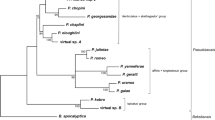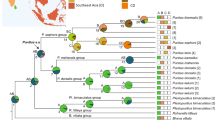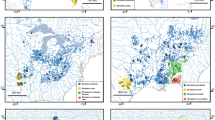Abstract
THE construction of artificial waterways connecting different faunal provinces provides biologists with an opportunity to observe ecological, biogeographic and evolutionary changes. But recognition of change requires a thorough knowledge of conditions before construction. The opening of the Suez Canal in 1857 is a case in point. More than thirty species of Red Sea fishes have been recorded as colonising the Mediterranean since the opening of the canal1, but because no reliable systematic ichthyological collections were made in the eastern Mediterranean before 1857, these new records must be judged with caution. We report here comparative electrophoretic evidence which suggests that the Red Sea cyprinodontid, Aphanius dispar, first reported along the Israeli coast in 1947 (ref. 2) and therefore considered a Suez migrant, has been a permanent Mediterranean resident for a long time.
This is a preview of subscription content, access via your institution
Access options
Subscribe to this journal
Receive 51 print issues and online access
$199.00 per year
only $3.90 per issue
Buy this article
- Purchase on Springer Link
- Instant access to full article PDF
Prices may be subject to local taxes which are calculated during checkout
Similar content being viewed by others
References
Ben-Tuvia, A., Israel J. Zool. 20, 1–39 (1971).
Mendelsohn, H., Nature, 160, 123 (1947).
Borsieri, C., Ann. Mus. Civ. Genova, 1, 187–220 (1904).
Ben-Tuvia, A., Bull. Res. Council Israel, 2, 439–440 (1953).
Neev, D., and Emery, K. O., Geol. Survey Israel Bull., 41, 1–147 (1967).
Goren, M., Israel J. Zool., 23, 67–118 (1974).
Villwock, W., Z. zool. Syst. Evolut-forsch., 2, 267–382 (1964).
Selander, R. K., Smith, M. H., Yang, S. Y., Johnson, W. E., and Gentry, G. B., Univ. Texas Publ., 7103, 49–90 (1971).
Rogers, J. S., Univ. Texas Publ., 7213, 145–153 (1972).
Avise, J. C., Syst. Zool., 23, 465–481 (1974).
Ayala, F. J., in Evolutionary Biology (edit. by Dobzhansky, T., Hecht, M. K., and Steere, W. C.), 1–78 (Plenum, New York, 1975).
Steinitz, H., Bonn. Zool. Beitr., 2, 113–124 (1951).
Gorman, G. C., Kim, Y. J., and Rubinoff, R., Copeia, 1976, 361–364 (1976).
Ben-Tuvia, A., Copeia, 1966, 254–275 (1966).
Por, F. D., Syst. Zool., 20, 138–159 (1971).
Sneh, A., Weissbrod, T., and Perath, I., Am. Sci., 63, 542–548 (1975).
Nei, M., Maruyama, T., and Chakraborty, R., Evolution, 29, 1–10 (1975).
Steinitz, H., Publ. Hydriobiol. Res. Inst. Univ. Instanbul, B 1, 225–275 (1954).
For, F. D., Zool. Sci., 4, 5–20 (1975).
Science, 191, 1131–1137 (1976).
Rubinoff, I., Science, 161, 857–861 (1968).
Aron, W. I., and Smith, S. H., Science, 17413–20 (1971).
Author information
Authors and Affiliations
Rights and permissions
About this article
Cite this article
KORNFIELD, I., NEVO, E. Likely pre-Suez occurrence of a Red Sea fish Aphanius dispar in the Mediterranean. Nature 264, 289–291 (1976). https://doi.org/10.1038/264289a0
Received:
Accepted:
Issue Date:
DOI: https://doi.org/10.1038/264289a0
This article is cited by
-
Environmental influences on regulation of blood plasma/serum components in teleost fishes: a review
Reviews in Fish Biology and Fisheries (2009)
-
Environmental influences on regulation of blood plasma/serum components in teleost fishes: a review
Reviews in Fish Biology and Fisheries (2009)
-
Allozymic variation of the endangered killifishAphanius iberus and its application to conservation
Environmental Biology of Fishes (1996)
-
Genetic variation in marine teleosts: High variability in habitat specialists and low variability in habitat generalists
Marine Biology (1982)
Comments
By submitting a comment you agree to abide by our Terms and Community Guidelines. If you find something abusive or that does not comply with our terms or guidelines please flag it as inappropriate.



